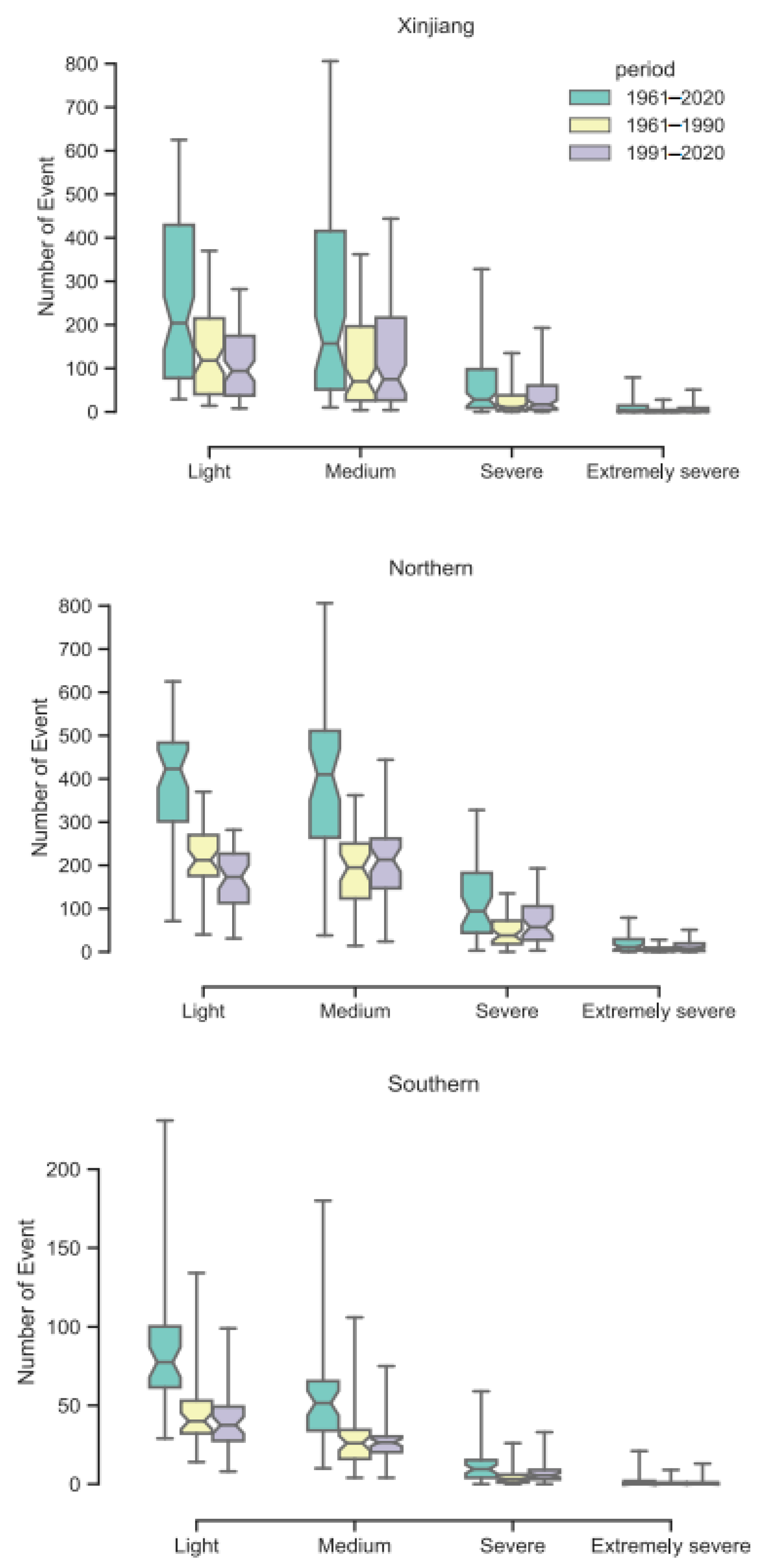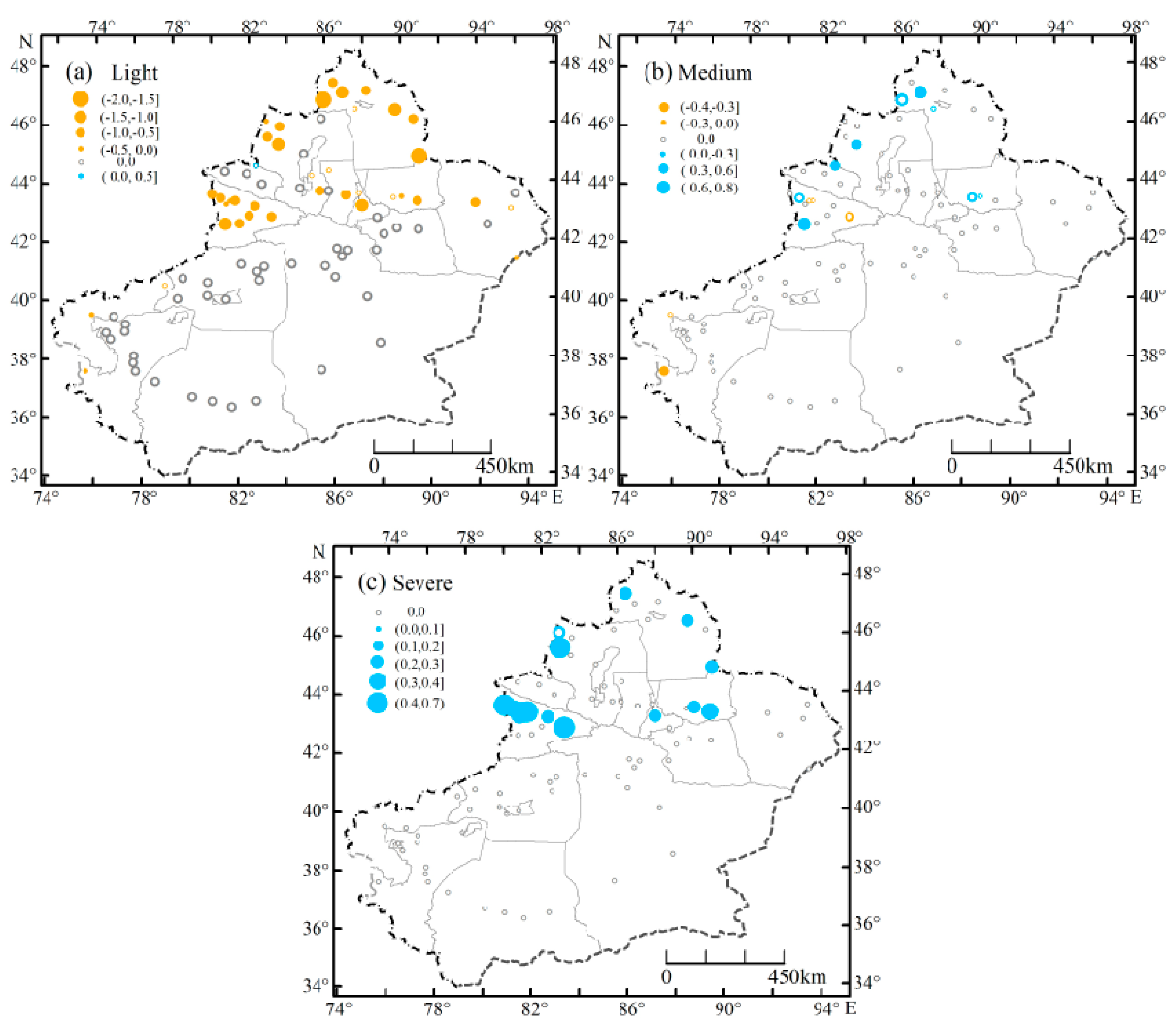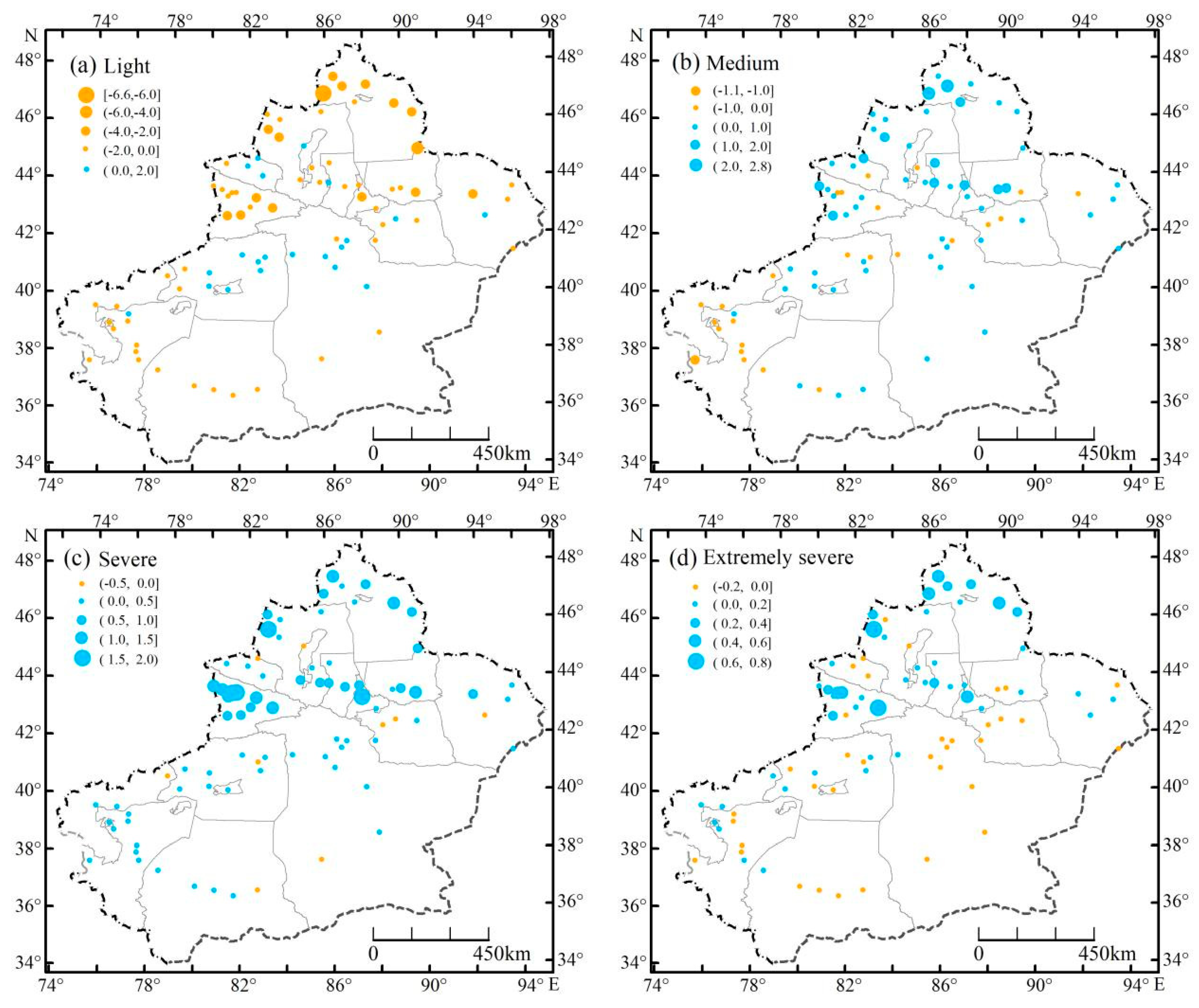The Spatiotemporal Characteristics of Urban Snow Disasters in Xinjiang over the Last 60 Years
Abstract
1. Introduction
2. Materials and Methods
2.1. Overview of the Study Area
2.2. Urban Snow Disaster Meteorological Classification
2.3. Sen Slope Estimation and the Mann–Kendall Test
2.4. Atmospheric Characteristic Indices
3. Results
3.1. Analysis of the Spatial and Temporal Variability of Urban Disasters in Xinjiang
3.1.1. Spatial Distribution of Different Grades of Snow Disasters
3.1.2. Spatial Distribution of Trends in Different Grades of Snow Disasters
3.1.3. Different Grades of Urban Snow Disaster Frequency at Different Periods
3.2. Relationship between Urban Snow Disasters and Atmospheric Circulation Indices
4. Discussion and Conclusions
Author Contributions
Funding
Data Availability Statement
Conflicts of Interest
References
- Wei, Y.; Wang, S.; Fang, Y.; Nawaz, Z. Integrated assessment on the vulnerability of animal husbandry to snow disasters under climate change in the Qinghai-Tibetan Plateau. Glob. Planet. Change 2017, 157, 139–152. [Google Scholar] [CrossRef]
- Qin, D.; Edi, D.C. China National Assessment Report on Risk Management and Adaptation of Climate Extremes and Disasters; Science Report: Beijing, China, 2015. [Google Scholar]
- Kunkel, K.E.; Robinson, D.A.; Champion, S.; Yin, X.; Estilow, T.; Frankson, R.M. Trends and extremes in Northern Hemisphere snow characteristics. Curr. Clim. Change Rep. 2016, 2, 65–73. [Google Scholar] [CrossRef]
- Chen, H.; Sun, J.; Lin, W. Anthropogenic influence would increase intense snowfall events over parts of the Northern Hemisphere in the future. Environ. Res. Lett. 2020, 15, 114022. [Google Scholar] [CrossRef]
- Ding, Y.; Wang, Z.; Song, Y.; Zhang, J. Causes of the unprecedented freezing disaster in January 2008 and its possible association with the global warming. Acta Meteorol. Sin. 2008, 66, 808–825. (In Chinese) [Google Scholar]
- Vavrus, S. The role of terrestrial snow cover in the climate system. Clim. Dyn. 2007, 29, 73–88. [Google Scholar] [CrossRef]
- Zhou, B.; Xu, Y.; Wu, J.; Dong, S.; Shi, Y. Changes in temperature and precipitation extreme indices over China: Analysis of a high-resolution grid dataset. Int. J. Climatol. 2016, 36, 1051–1066. [Google Scholar] [CrossRef]
- Zhou, B.; Gu, L.; Ding, Y.; Shao, L.; Wu, Z.; Yang, X.; Li, C.; Li, Z.; Wang, X.; Cao, Y.; et al. The great 2008 Chinese ice storm: Its socioeconomic-ecological impact and sustainability lessons learned. Bull. Am. Meteorol. Soc. 2011, 92, 47–60. [Google Scholar] [CrossRef]
- Zhuang, X.; Zhou, H.; Wang, L.; Li, B. Evaluation and cause study on the snow disasters in pastoral areas of northern Xinjiang. Arid. Zone Res. 2015, 32, 1000–1006. [Google Scholar]
- Lin, W.; Chen, H. Changes in the spatial–temporal characteristics of daily snowfall events over the Eurasian continent from 1980 to 2019. Int. J. Climatol. 2022, 42, 1841–1853. [Google Scholar] [CrossRef]
- Guo, X.; Li, L.; Liu, C.; Wang, F.; Li, B. Spatio-temporal distribution of snow disaster in Qinghai Plateau during 1961–2008. Adv. Clim. Change Res. 2010, 6, 332–337. [Google Scholar]
- Wang, X.; Chu, C.-J.; Mou, H. Spatial pattern and interannual variation characteristics of snow disaster in Xinjiang. Arid. Zone Res. 2020, 37, 1488–1495. [Google Scholar]
- Liu, C.; Yu, J.; Yang, Y. A study of the response of snow disaster frequency to sea surface temperature forcing anomaly forcing over the Qinghai-Xizang Plateau. Plateau Meteorol. 2021, 40, 486–494. [Google Scholar]
- Huang, X.; Tang, S.; Ciwang, D. Variation of the snow disasters under global warming and its relationship with general circulation over Tibetan Plateau. Plateau Meteorol. 2018, 37, 325–332. [Google Scholar]
- Li, H.; Xi, W.; Zhang, L.; Zang, S. Snow-disaster risk zoning and assessment in Heilongjiang Province. Sustainability 2021, 13, 14010. [Google Scholar] [CrossRef]
- Li, J.; Zou, Y.; Zhang, Y.; Sun, S.; Dong, X. Risk assessment of snow disasters for animal husbandry on the Qinghai–Tibetan Plateau and influences of snow disasters on the well-being of farmers and pastoralists. Remote Sens. 2022, 14, 3358. [Google Scholar] [CrossRef]
- Liu, D.; Zhang, L.; Jiang, S.; Shi, S.; Li, Y. Hazard prediction and risk regionalization of snowstorms in northeast China. Phys. Chem. Earth Parts A/B/C 2019, 116, 102832. [Google Scholar] [CrossRef]
- Wang, S.; Zhou, L.; Wei, Y. Integrated risk assessment of snow disaster over the Qinghai-Tibet Plateau. Geomat. Nat. Hazards Risk 2019, 10, 740–757. [Google Scholar]
- Yang, D.; Liu, F.; Yan, J.; Zhang, Y.; Zhou, Q. A risk assessment of snow disaster along Qinghai-Tibet Railway. Geogr. Res. 2021, 40, 1223–1238. [Google Scholar]
- Dai, Y.; Chen, D.; Yao, T.; Wang, L. Large lakes over the Tibetan Plateau may boost snow downwind: Implications for snow disaster. Sci. Bull. 2020, 65, 1713–1717. [Google Scholar] [CrossRef]
- Wang, S.; Sheng, Y.; Wei, Y. Risk prevention and control strategies for the severely affected areas of snow disaster in the Three Rivers Source Region (TRSR). China Sci. Cold Arid. Reg. 2019, 11, 80–84. [Google Scholar]
- Alexander, L.V. Global observed long-term changes in temperature and precipitation extremes: A review of progress and limitations in IPCC assessments and beyond. Weather. Clim. Extrem. 2016, 11, 4–16. [Google Scholar] [CrossRef]
- IPCC. Summary for Policymakers. In Climate Change 2021: The Physical Science Basis. Contribution of Working Group I to the Sixth Assessment Report of the Intergovernmental Panel on Climate Change; Cambridge University Press: Cambridge, UK, 2021; p. 2391. [Google Scholar]
- Paik, S.; Min, S.; Zhang, X.; Donat, M.G.; King, A.D.; Sun, Q. Determining the anthropogenic greenhouse gas contribution to the observed intensification of extreme precipitation. Geophys. Res. Lett. 2020, 47, e2019GL086875. [Google Scholar] [CrossRef]
- Dong, S.; Sun, Y.; Li, C. Detection of Human Influence on Precipitation Extremes in Asia. J. Clim. 2020, 33, 5293–5304. [Google Scholar] [CrossRef]
- Burke, C.; Stott, P. Impact of Anthropogenic Climate Change on the East Asian Summer Monsoon. J. Clim. 2017, 30, 5205–5220. [Google Scholar] [CrossRef]
- Ma, S.; Zhou, T.; Stone, D.A.; Polson, D.; Dai, A.; Stott, P.A.; von Storch, H.; Qian, Y.; Burke, C.; Wu, P. Detectable anthropogenic shift toward heavy precipitation over Eastern China. J. Clim. 2017, 30, 1381–1396. [Google Scholar] [CrossRef]
- Dong, S.; Sun, Y.; Zhang, X. Attributing observed increase in extreme precipitation in China to human influence. Environ. Res. Lett. 2022, 17, 095005. [Google Scholar] [CrossRef]
- Zhang, C.; Tang, Q.; Chen, D.; Van der Ent, R.J.; Liu, X.; Li, W.; Haile, G.G. Moisture source changes contributed to different precipitation changes over the northern and southern Tibetan Plateau. J. Hydrometeorol. 2019, 20, 217–229. [Google Scholar] [CrossRef]
- O’Gorman, P.A. Contrasting responses of mean and extreme snowfall to climate change. Nature 2014, 512, 416–418. [Google Scholar] [CrossRef]
- Xi, S.; Zhang, Z. Spatial and temporal analysis of snow cover in China in recent 50 years. J. Arid. Meteorol. 2013, 31, 451–456. [Google Scholar]
- Wang, H.; Wang, M.; Wang, S.; Yu, X. Spatial-temporal variation characteristics of snow cover duration in Xinjiang from 1961 to 2017 and their relationship with meteorological factors. J. Glaciol. Geocryol. 2021, 43, 61–69. [Google Scholar]
- Yang, X.; Li, A.; Zhao, Y.; Wei, J. Spatial-temporal distribution and general circulation of snowstorm in northern Xinjiang from 1961 to 2018. J. Glaciol. Geocryol. 2020, 42, 756–765. [Google Scholar]
- Wang, X.; Lu, X.; Ma, Y.; Wang, X. Study on snow disaster assessment method and snow disaster regionalization in Xinjiang. J. Glaciol. Geocryol. 2019, 41, 836–844. [Google Scholar]
- Wang, Y.; Zhao, Z.; Yan, J.; Tang, Y.; Cai, Y. Spatial and temporal distribution characteristics and its classification of snow disaster in Xinjiang. Arid. Land Geogr. 2020, 43, 577–583. [Google Scholar]
- Yao, J.; Chen, Y.; Guan, X.; Zhao, Y.; Chen, J.; Mao, W. Recent climate and hydrological changes in a mountain–basin system in Xinjiang; China. Earth-Sci. Rev. 2022, 226, 103957. [Google Scholar] [CrossRef]
- Shi, Y. Chinese Meteorological Disaster Canon: Xinjiang Volume; China Meteorological Press: Beijing, China, 2006. [Google Scholar]
- Allen, S.; Frey, H.; Huggel, C. Assessment of Glacier and Permafrost Hazards in Mountain Regions; Technical Guidance Document; GAPHAZ: Zurich, Switzerland; Lima, Peru, 2017; pp. 6–9. [Google Scholar]
- China Meteorological Administration. Meteorological Grades for Urban Snow Hazard (QX/T 178-2013); China Meteorological Press: Beijing, China, 2013. [Google Scholar]
- Kendall, M.G. Rank correlation measures. Charles Griffin Lond. 1975, 202, 15. [Google Scholar]
- Mann, H.B. Nonparametric tests against trend. Econom. J. Econom. Soc. 1945, 13, 245–259. [Google Scholar] [CrossRef]
- Wang, H.; Wang, S.; Yu, X.; Wang, M.; Han, X. Spatial-temporal variation of snow cover in Xinjiang based on surface observation from 1961 to 2017. J. Glaciol. Geocryol. 2020, 42, 150–158. [Google Scholar]
- Yang, L.; Yang, T.; Jia, L.H.; Chang, T. Analyses of climate characteristics and water vapor of heavy snow in Xinjiang Region. J. Glaciol. Cryopedology 2005, 27, 389–396. [Google Scholar]
- Liu, Y.; Ren, G.; Yu, H.; Kang, H. Climatic characteristics of intense snowfall in China with its variation. J. Appl. Meteorol. Sci. 2013, 24, 304–313. [Google Scholar]
- Guan, X.; Sun, W.; Li, M. Climate change in North Xinjiang and its response to Arctic Oscillation during the period of 1965—2012. Arid. Zone Res. 2016, 33, 681–689. [Google Scholar]
- Zhuang, X.; Li, B.; Li, R.; Zhou, H. Some advances on study of strong snowfall in Northern Xinjiang. Desert Oasis Meteorol. 2016, 10, 1–8. [Google Scholar]
- Wang, W.; Liu, Y.; Zhao, Q.; Qin, Y.; Meng, X.; Zhang, M.; Jin, Z. Spatiotemporal characteristics of extreme precipitation and its response to temperature change in Xinjiang; China. Trans. Chin. Soc. Agric. Eng. (Trans. CSAE) 2022, 38, 133–142. [Google Scholar]
- Liu, C.; An, D.; Zhang, J. Variation characteristics of different levels of snowfall in winter over Northern Xinjiang from 1961 to 2019. Desert Oasis Meteorol. 2021, 15, 115–122. [Google Scholar]









| Serial Number | Meteorological Factor | The Corresponding Component Value in the Urban Snow Disaster Meteorological Index | |||||
|---|---|---|---|---|---|---|---|
| 1 | Accumulated snowfall/mm | ≤4.9 | 5.0~9.9 | 10.0~19.9 | 20.0~29.9 | 30.0~39.9 | ≥40.0 |
| IR | 8 | 16 | 24 | 32 | 40 | 48 | |
| 2 | The maximum daily snowfall/mm | ≤2.4 | 2.5~4.9 | 5.0~9.9 | 10.0~19.9 | 20.0~29.9 | ≥30.0 |
| IRM | 8 | 16 | 24 | 32 | 40 | 48 | |
| 3 | Snow depth/cm | ≤9.9 | 10.0~19.9 | 20.0~29.9 | 30.0~39.9 | 40.0~49.9 | ≥50.0 |
| ID | 4 | 8 | 12 | 16 | 20 | 24 | |
| 4 | The number of consecutive days of snowfall/d | 1 | 2 | 3~4 | 5~6 | 7~8 | ≥9 |
| IN | 3 | 6 | 9 | 12 | 15 | 18 | |
| 5 | Daily minimum temperature/°C | ≤−15.0 | −14.9~−10.0 | −9.9~−7.0 | −6.9~−5.0 | −4.9~−3.0 | −2.9~−1.0 |
| IT | 3 | 6 | 9 | 12 | 15 | 18 | |
| 6 | Daily maximum wind speed/(m/s) | ≤1.5 | 1.6~3.3 | 3.4~5.4 | 5.5~7.9 | 8.0~10.7 | ≥10.8 |
| IW | 2 | 4 | 6 | 8 | 10 | 12 | |
| 7 | Daily minimum relative humidity/% | ≤49.9 | ≥50 | ||||
| IRH | 4 | 8 | |||||
| Grade | Grade Description | Index Range |
|---|---|---|
| Ⅰ | Light | [34, 44] |
| Ⅱ | Medium | [45, 70] |
| Ⅲ | Severe | [71, 99] |
| Ⅳ | Extremely severe | [100, 192] |
| Month | 1 | 2 | 3 | 4 | 5 | 6 | 7 | 8 | 9 | 10 | 11 | 12 |
|---|---|---|---|---|---|---|---|---|---|---|---|---|
| Characteristic contour/dagpm | 548 | 552 | 552 | 552 | 560 | 568 | 572 | 572 | 568 | 564 | 556 | 552 |
| Region | Projects | Northern Hemisphere Polar Vortex Central Intensity Index | India-Burma Trough Intensity Index | AO | ||||||
|---|---|---|---|---|---|---|---|---|---|---|
| Winter Half-Year | Autumn | Winter | Winter Half-Year | Autumn | Winter | Winter Half-Year | Autumn | Winter | ||
| Northern | Light | −0.278 | −0.154 | −0.062 | −0.241 | −0.241 | −0.254 | −0.061 | 0.038 | −0.094 |
| Medium | 0.136 | 0.134 | 0.186 | 0.351 * | 0.340 * | 0.342 * | −0.093 | −0.072 | −0.077 | |
| Severe | 0.484 ** | 0.336 * | 0.453 ** | 0.535 ** | 0.497 ** | 0.510 ** | −0.211 | −0.159 | −0.193 | |
| Extremely severe | 0.507 ** | 0.333 * | 0.478 ** | 0.434 ** | 0.372 ** | 0.388 ** | −0.397 ** | −0.217 | −0.353 * | |
| Southern | Light | −0.155 | −0.247 | −0.115 | 0.043 | 0.066 | −0.022 | −0.131 | 0.051 | −0.177 |
| Medium | −0.013 | −0.018 | −0.054 | 0.116 | 0.139 | 0.084 | −0.068 | 0.086 | −0.049 | |
| Severe | 0.134 | 0.037 | 0.092 | 0.344 * | 0.349 * | 0.278 | −0.168 | −0.047 | −0.108 | |
| Extremely severe | −0.093 | −0.021 | −0.082 | 0.185 | 0.263 | 0.123 | −0.046 | −0.086 | −0.002 | |
Disclaimer/Publisher’s Note: The statements, opinions and data contained in all publications are solely those of the individual author(s) and contributor(s) and not of MDPI and/or the editor(s). MDPI and/or the editor(s) disclaim responsibility for any injury to people or property resulting from any ideas, methods, instructions or products referred to in the content. |
© 2023 by the authors. Licensee MDPI, Basel, Switzerland. This article is an open access article distributed under the terms and conditions of the Creative Commons Attribution (CC BY) license (https://creativecommons.org/licenses/by/4.0/).
Share and Cite
Wang, H.; Dong, S.; Wang, M.; Yu, X.; Wang, S.; Liu, J. The Spatiotemporal Characteristics of Urban Snow Disasters in Xinjiang over the Last 60 Years. Atmosphere 2023, 14, 802. https://doi.org/10.3390/atmos14050802
Wang H, Dong S, Wang M, Yu X, Wang S, Liu J. The Spatiotemporal Characteristics of Urban Snow Disasters in Xinjiang over the Last 60 Years. Atmosphere. 2023; 14(5):802. https://doi.org/10.3390/atmos14050802
Chicago/Turabian StyleWang, Hui, Siyan Dong, Meixia Wang, Xingjie Yu, Shengli Wang, and Jing Liu. 2023. "The Spatiotemporal Characteristics of Urban Snow Disasters in Xinjiang over the Last 60 Years" Atmosphere 14, no. 5: 802. https://doi.org/10.3390/atmos14050802
APA StyleWang, H., Dong, S., Wang, M., Yu, X., Wang, S., & Liu, J. (2023). The Spatiotemporal Characteristics of Urban Snow Disasters in Xinjiang over the Last 60 Years. Atmosphere, 14(5), 802. https://doi.org/10.3390/atmos14050802






